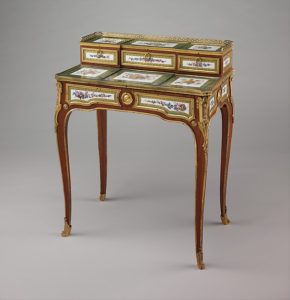By Elizabeth Lyons
Title: Small Writing Desk (Bonheur-du-jour)
Artists: Made by Martin Carlin (French, near Freiburg im Bresigau ca. 1730-1785 Paris); decorated by Denis Levé (French, active 1754-93, 1795-1805);porcelain plaques by Sèvres Manufactory
Date: ca. 1768
Medium: Oak veneered with tulipwood, amaranth, and stained sycamore; mahogany; seventeen soft-paste porcelain plaques; gilt-bronze mounts; velvet (not original)
Dimensions: 32 1/2 × 25 7/8 × 16 in. (82.6 × 65.7 × 40.6 cm)
Classification: Woodwork-Furniture
Metropolitan Museum of Art
Credit Line: Gift of Samuel H. Kress Foundation, 1958
Accession Number: 58.75.48
The bonheur-du-jour is a small, elegantly decorated women’s writing desk that became a popular addition to the interiors of elite French residences during the 1760s. This desk, dated to circa 1768, is attributed to the cabinetmaker Martin Carlin. Letter-writing was one of the most popular activities of the time, especially for ladies, and this desk was invented with the needs of writing in mind and was intended to be used specifically by women. 1 Although the origins of the desk’s name is not known, it may have evoked the pleasure and enjoyment its female owner gained from writing, since the French phrase “bonheur-du-jour” translates to “happiness of the day.” This example is thought to have belonged to Madame du Berry, the official mistress of the French King Louis XV (r. 1715-1774), who purchased a total of eleven bonheurs-du-jour for her apartments in the château de Versailles. Twelve of the desk’s porcelain plaques are dated to 1768, the same year that Madame du Berry bought her desks from the marchand-mercier Simon-Philippe Poirier. In addition, an inventory record of her private apartments includes a piece that is very similar, and perhaps they are the same desk. 2
Furniture, textiles, and other luxury accoutrements enhanced the residential interiors of the European elite during the eighteenth century in ways never before imagined. Consumerism at this time in France was becoming an important factor in society, and objects such as the bonheur-du-jour played a role in this new facet of the economy. Innovation and customization developed in furniture based on the needs of the consumer. 3 As decorative objects became increasingly elaborate, their functions became ever more complex. Understanding how a piece functioned and how to properly use it became a way to measure and display one’s social status. As Mimi Hellman writes, “such an object had as great a capacity to expose an individual’s awkwardness as to emphasize his or her graceful control.”4 The way a person interacted with a piece of furniture became incredibly important within eighteenth-century French society. A person’s class could be recognized with respect to how they engaged with the furniture in a room and whether they handled each object according to its proper instructions. Upon first glance, a piece of furniture might seem to work one way, but oftentimes it was outfitted with hidden compartments or featured hidden uses that only a knowledgeable owner would understand how to use correctly. 5
The bonheur-du-jour contains a drawer in the front panel that opens to reveal a compartment with a writing surface as well as space for the storage of inkwells, sponges, and sand (for blotting ink) to have at the ready for writing. There is a pushed-back second tier with three small drawers that open for even more storage space. The desk is relatively small and portable so that it could be easily moved from one room to another. The entire piece stands on four curved legs made of wood and is adorned with seventeen porcelain plaques of a floral design with a multitude of different colors fitted into a green border and surrounded by gilt bronze moldings. The addition of porcelain to the desk makes it an even more luxurious commodity. This porcelain was manufactured at the renowned Sèvres factory outside of Paris, the leader in high-end European porcelain production at the time.
Where the bonheur-du-jour of Madame du Berry went after the king’s death and the transformation of her possessions to her château at Louveciennes is unknown. This desk, however, was purchased by London banker Charles Mills during the nineteenth century and later found its way into the collection of American businessman Samuel H. Kress, whose estate gifted it to the Metropolitan Museum of Art in 1958. 6
- Dena Goodman, “Furnishing Discourses: Readings of a Writing Desk in Eighteenth-Century France,” in Luxury in the Eighteenth Century: Debates, Desires and Delectable Goods, ed. Maxine Berg and Elizabeth Eger (New York: Palgrave Macmillan, 2002), 82. ↩
- Daniëlle O. Kisluk-Grosheide, “French Royal Furniture in the Metropolitan Museum,” The Metropolitan Museum of Art Bulletin 63, no. 3 (Winter 2006): 14-15. ↩
- Goodman, “Furnishing Discourses,” 73-74. ↩
- Mimi Hellman, “Furniture, Sociability, and the Work of Leisure in Eighteenth-Century France,” Eighteenth-Century Studies 32, no. 4 (1999): 423. ↩
- Hellman, “Furniture, Sociability, and the Work of Leisure in Eighteenth-Century France,” 419-430. ↩
- Kisluk-Grosheide, “French Royal Furniture in the Metropolitan Museum,” 14-15. ↩
